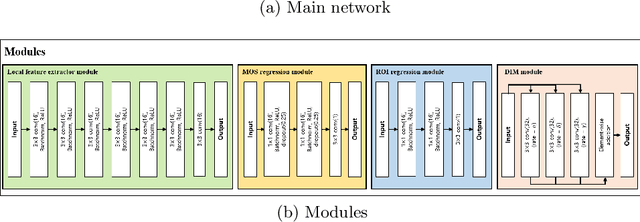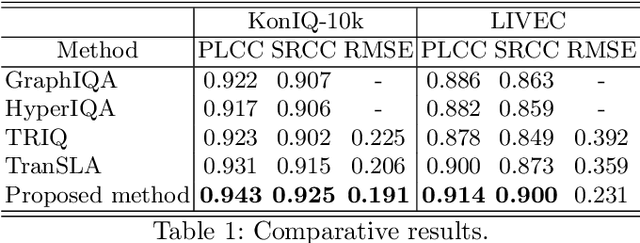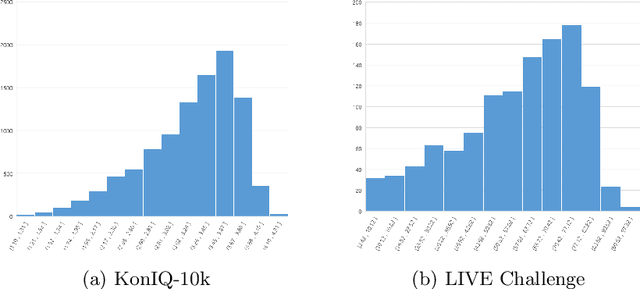Anant Baijal
Pixel-by-pixel Mean Opinion Score for No-Reference Image Quality Assessment
Jun 14, 2022



Abstract:Deep-learning based techniques have contributed to the remarkable progress in the field of automatic image quality assessment (IQA). Existing IQA methods are designed to measure the quality of an image in terms of Mean Opinion Score (MOS) at the image-level (i.e. the whole image) or at the patch-level (dividing the image into multiple units and measuring quality of each patch). Some applications may require assessing the quality at the pixel-level (i.e. MOS value for each pixel), however, this is not possible in case of existing techniques as the spatial information is lost owing to their network structures. This paper proposes an IQA algorithm that can measure the MOS at the pixel-level, in addition to the image-level MOS. The proposed algorithm consists of three core parts, namely: i) Local IQA; ii) Region of Interest (ROI) prediction; iii) High-level feature embedding. The Local IQA part outputs the MOS at the pixel-level, or pixel-by-pixel MOS - we term it 'pMOS'. The ROI prediction part outputs weights that characterize the relative importance of region when calculating the image-level IQA. The high-level feature embedding part extracts high-level image features which are then embedded into the Local IQA part. In other words, the proposed algorithm yields three outputs: the pMOS which represents MOS for each pixel, the weights from the ROI indicating the relative importance of region, and finally the image-level MOS that is obtained by the weighted sum of pMOS and ROI values. The image-level MOS thus obtained by utilizing pMOS and ROI weights shows superior performance compared to the existing popular IQA techniques. In addition, visualization results indicate that predicted pMOS and ROI outputs are reasonably aligned with the general principles of the human visual system (HVS).
Analyzing Images for Music Recommendation
May 15, 2021



Abstract:Experiencing images with suitable music can greatly enrich the overall user experience. The proposed image analysis method treats an artwork image differently from a photograph image. Automatic image classification is performed using deep-learning based models. An illustrative analysis showcasing the ability of our deep-models to inherently learn and utilize perceptually relevant features when classifying artworks is also presented. The Mean Opinion Score (MOS) obtained from subjective assessments of the respective image and recommended music pairs supports the effectiveness of our approach.
Sports highlights generation based on acoustic events detection: A rugby case study
Sep 18, 2015



Abstract:We approach the challenging problem of generating highlights from sports broadcasts utilizing audio information only. A language-independent, multi-stage classification approach is employed for detection of key acoustic events which then act as a platform for summarization of highlight scenes. Objective results and human experience indicate that our system is highly efficient.
Application of PSO, Artificial Bee Colony and Bacterial Foraging Optimization algorithms to economic load dispatch: An analysis
Nov 13, 2011



Abstract:This paper illustrates successful implementation of three evolutionary algorithms, namely- Particle Swarm Optimization(PSO), Artificial Bee Colony (ABC) and Bacterial Foraging Optimization (BFO) algorithms to economic load dispatch problem (ELD). Power output of each generating unit and optimum fuel cost obtained using all three algorithms have been compared. The results obtained show that ABC and BFO algorithms converge to optimal fuel cost with reduced computational time when compared to PSO for the two example problems considered.
 Add to Chrome
Add to Chrome Add to Firefox
Add to Firefox Add to Edge
Add to Edge